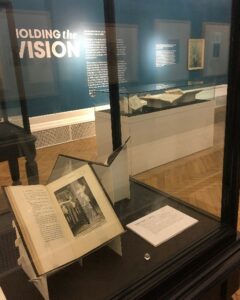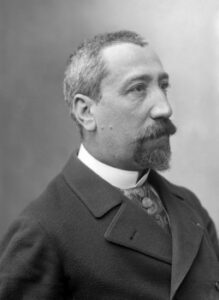Anatole France, The Revolt of the Rebel Angels, Bodley Head, 1914
26 June 2020
By Dr Cynthia Johnston, Institute of English Studies, School of Advanced Study, University of London

Anatole France, The Revolt of the Rebel Angels, translated by Mrs Wilfrid Jackson, illustrated by Frank C. Pape, (London: Johns Lane at the Bodley Head, 1914). Seen on display in the Holding the Vision exhibition. On loan from the Harris Museum, Art Gallery and Library.
Anatole France (1844-1924) was not only awarded the Nobel Prize for literature, he also managed to have all of his works banned by the Catholic Church from 1922 until the disbandment of the Index Librorum Prohibitorum in 1966. This, France claimed, was his greatest honour.
France’s work brings together many elements of the collections and collectors we have discussed through this blog for Holding the Vision. France was the son of a bookseller, and collected books all his life. He began his literary career as a poet and journalist and published his first novel, Le Crime de Sylvestre Bonnard in 1881. France’s work always carried a satirical slant, and with The Revolt of the Rebel Angels, he finally pushed the Catholic church, at least, too far. Published just before the outbreak of the First World War, La Revolte des Anges follows the Miltonic model in narrating the ‘War in Heaven’ whose catalysts are the ‘Rebel Angels’. In France’s novel, the revolt of the rebel angels is led by a guardian angel, Arcade, who is bored by his thankless task of guarding the virtue of the sinless Bishop d’Esparvieu. To amuse himself, Arcade begins to explore the books in the Bishop’s library. The books are found in odd places, and some witness the books floating through space, as the invisible Arcade carries them around. What Arcade discovers through his reading is science:
I have devoured the works of theologians, philosophers, physicists, geologists, and naturalists. I have learnt. I have thought. I have lost my faith.

Anatole France, 1889.
The revolt of the rebel angels ensues. In spite, or perhaps because, of the great offense the book caused, it was immensely popular. Our edition was produced by John Lane, who had established the Bodley Head Press with Elkin Mathews in 1887. The Revolt of the Rebel Angels was a perfect fit for the Bodley Head, whose stated aim was to ‘publish works of stylish decadence’. The Bodley Head published the famous Yellow Book magazine, a favourite of John Henry Spencer’s and his friends in Preston during the 1890s. With Aubrey Beardsley as its art editor, the Yellow Book, brought the new literature and art of the aesthetic movement to its readers, and succeeded in shocking conservative Victorian sensibilities.
With this, I will draw this blog to a close, and thank you all for your readership. I hope that the you may be able to catch a glimpse of the exhibition when the museum reopens. We’ll keep you up to date on developments.∗
∗ We are pleased to announce that Blackburn Museum and Art Gallery will reopen to the public from Wednesday 15th July 2020. Full details will follow on our website soon. There will be an opportunity to visit The Holding the Vision Exhibition from Wednesday 15 July to Saturday 1 August. Can’t wait to see you there! (BMAAG 26 June 2020)